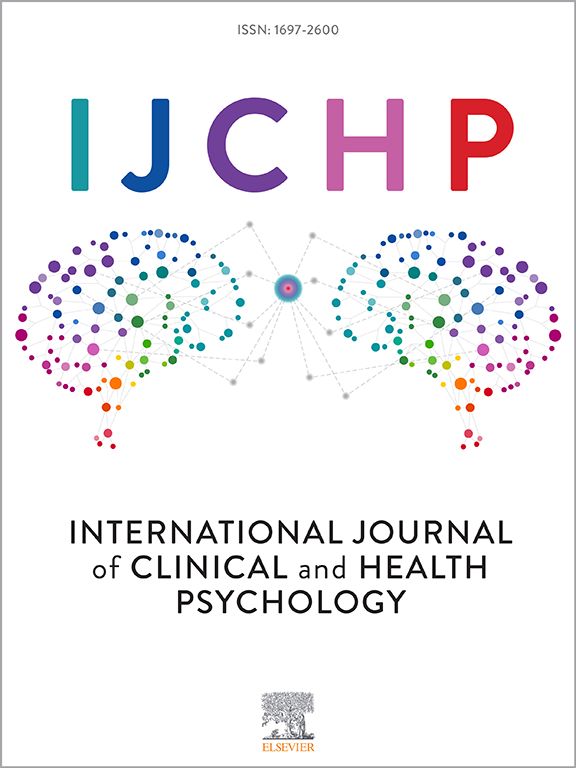Feasibility of a breath robot intervention to reduce sleep problems in posttraumatic stress disorder: A randomized controlled study
IF 4.4
1区 心理学
Q1 PSYCHOLOGY, CLINICAL
International Journal of Clinical and Health Psychology
Pub Date : 2025-04-01
DOI:10.1016/j.ijchp.2025.100594
引用次数: 0
Abstract
Background: Patients with Posttraumatic stress disorder (PTSD) suffer from sleep problems. Robot interventions offer a novel approach to reducing these problems. However, it is unclear whether patients with PTSD accept and regularly use a robot intervention and whether it is effective. Objective: This randomized controlled study evaluated the feasibility of a novel breath robot intervention in PTSD patients. Methods: Thirty-one adults with PTSD according to DSM-V (PSSI-5) with impaired sleep (PSQI > 5) were randomly assigned to a 4-week robot intervention (Somnox 2) with human breath simulation or to a 4-week robot intervention without human breath simulation. The primary feasibility outcome was the proportion of randomized participants providing outcome data at post-treatment. Secondary feasibility outcomes involved eligibility rate, recruitment speed, uptake, retention, treatment adherence, and dropout, clinical outcomes included sleep quality (PSQI), PTSD symptoms (PSSI-5), distress (PSS-10), and well-being (WHO-5). Results: Outcome data were provided by 96.8 %; eligibility rate was 75.6 %; 31 patients were recruited within 6 months; uptake and retention were 100 %; treatment adherence was 93.8 % in the intervention and 92.9 % in the active control group; dropout was 0 %. Distress decreased significantly more in the intervention group compared to the active control group (SMD = 0.67, 95 % CI 0.39, 0.94), but sleep quality, PTSD symptoms, and well-being did not improve significantly more. Conclusions: The use of a 4-week breath robot intervention was feasible and highly accepted in patients with severe PTSD. The breath robot intervention may reduce distress but may not be superior to a robot intervention without breath simulation for improving sleep and PTSD symptoms. Future trials should further determine the intervention’s clinical benefit.
呼吸机器人干预减少创伤后应激障碍患者睡眠问题的可行性:一项随机对照研究
背景:创伤后应激障碍(PTSD)患者存在睡眠问题。机器人干预为减少这些问题提供了一种新的方法。然而,尚不清楚创伤后应激障碍患者是否接受并定期使用机器人干预,以及它是否有效。目的:本随机对照研究评估一种新型呼吸机器人干预PTSD患者的可行性。方法:31例符合DSM-V (PSSI-5)的成人PTSD伴睡眠障碍(PSQI >;5)被随机分配到一个为期4周的机器人干预组(Somnox 2),并进行人类呼吸模拟,或一个为期4周的机器人干预组,不进行人类呼吸模拟。主要可行性结果是在治疗后提供结果数据的随机参与者的比例。次要可行性结局包括合格率、招募速度、吸收、保留、治疗依从性和退出,临床结局包括睡眠质量(PSQI)、PTSD症状(PSSI-5)、痛苦(PSS-10)和幸福感(WHO-5)。结果:结局资料提供率为96.8%;合格率75.6%;6个月内招募31例患者;吸收和保留率均为100%;干预组治疗依从性为93.8%,积极对照组为92.9%;辍学率为0%。与积极对照组相比,干预组的痛苦明显减少(SMD = 0.67, 95% CI 0.39, 0.94),但睡眠质量、PTSD症状和幸福感并没有显著改善。结论:在严重创伤后应激障碍患者中使用4周呼吸机器人干预是可行的,并且被高度接受。呼吸机器人干预可以减少痛苦,但在改善睡眠和PTSD症状方面可能并不优于不进行呼吸模拟的机器人干预。未来的试验应进一步确定干预的临床效益。
本文章由计算机程序翻译,如有差异,请以英文原文为准。
求助全文
约1分钟内获得全文
求助全文
来源期刊

International Journal of Clinical and Health Psychology
PSYCHOLOGY, CLINICAL-
CiteScore
10.70
自引率
5.70%
发文量
38
审稿时长
33 days
期刊介绍:
The International Journal of Clinical and Health Psychology is dedicated to publishing manuscripts with a strong emphasis on both basic and applied research, encompassing experimental, clinical, and theoretical contributions that advance the fields of Clinical and Health Psychology. With a focus on four core domains—clinical psychology and psychotherapy, psychopathology, health psychology, and clinical neurosciences—the IJCHP seeks to provide a comprehensive platform for scholarly discourse and innovation. The journal accepts Original Articles (empirical studies) and Review Articles. Manuscripts submitted to IJCHP should be original and not previously published or under consideration elsewhere. All signing authors must unanimously agree on the submitted version of the manuscript. By submitting their work, authors agree to transfer their copyrights to the Journal for the duration of the editorial process.
 求助内容:
求助内容: 应助结果提醒方式:
应助结果提醒方式:


